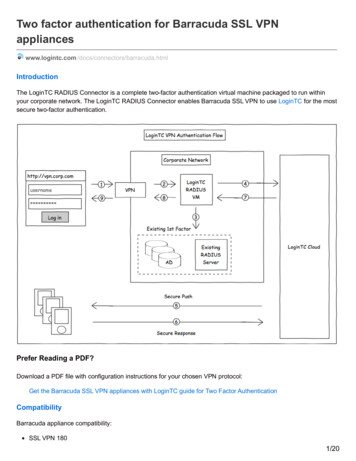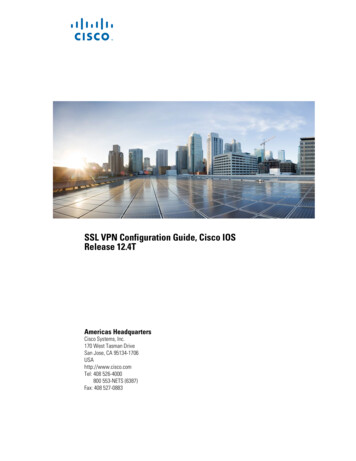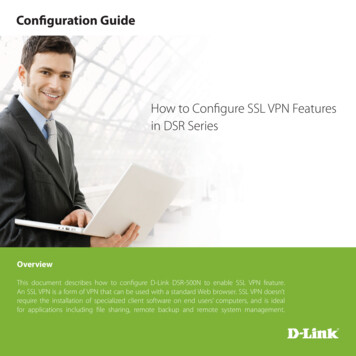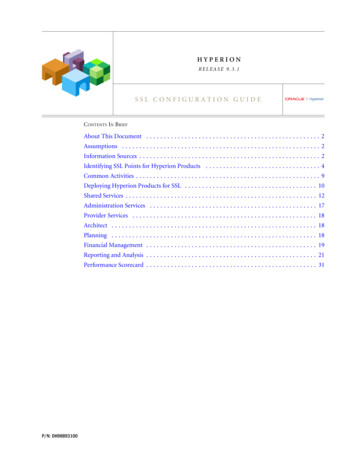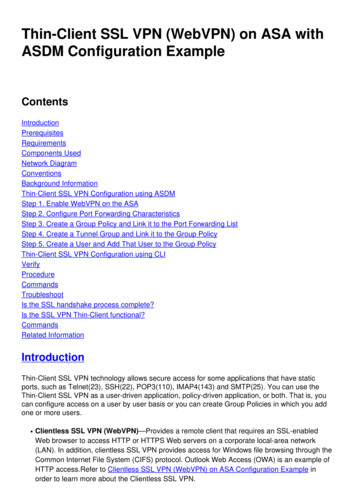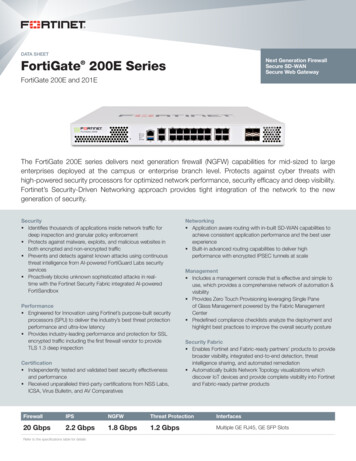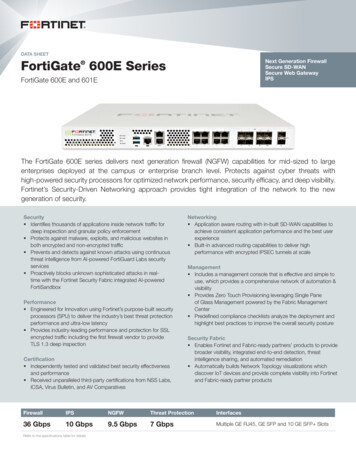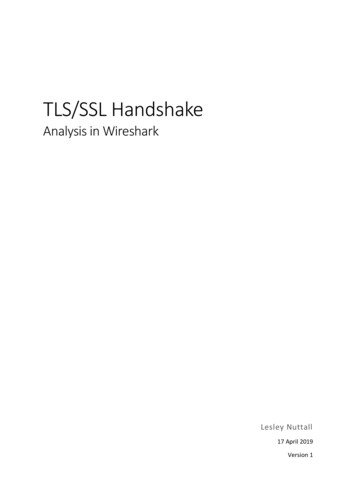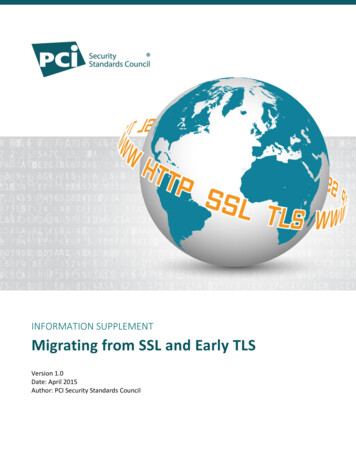
Transcription
INFORMATION SUPPLEMENTMigrating from SSL and Early TLSVersion 1.0Date: April 2015Author: PCI Security Standards Council
INFORMATION SUPPLEMENTMigrating from SSL and Early TLSExecutive SummaryThe time to migrate is now.For over 20 years Secure Sockets Layer (SSL) has been in the market as one of the most widely-used encryption protocols ever released,and remains in widespread use today despite various security vulnerabilities exposed in the protocol.Fifteen years ago, SSL v3.0 was superseded by TLS v1.0, which has since been superseded by TLS v1.1 and v1.2. To date, SSL and early TLSno longer meet minimum security standards due to security vulnerabilities in the protocol for which there are no fixes. It is criticallyimportant that entities upgrade to a secure alternative as soon as possible, and disable any fallback to both SSL and early TLS.SSL has been removed as an example of strong cryptography in the PCI DSS, and can no longer be used as a security control after June 30,2016.What is the risk?SSL/TLS encrypts a channel between two endpoints (for example, between a web browser and web server) to provide privacy andreliability of data transmitted over the communications channel. Since the release of SSL v3.0, several vulnerabilities have beenidentified, most recently in late 2014 when researchers published details on a security vulnerability (CVE-2014-3566) that may allowattackers to extract data from secure connections. More commonly referred to as POODLE (Padding Oracle On Downgraded LegacyEncryption), this vulnerability is a man-in-the-middle attack where it’s possible to decrypt an encrypted message secured by SSL v3.0.The SSL protocol (all versions) cannot be fixed; there are no known methods to remediate vulnerabilities such as POODLE. SSL and earlyTLS no longer meet the security needs of entities implementing strong cryptography to protect payment data over public or untrustedcommunications channels. Additionally, modern web browsers will begin prohibiting SSL connections in the very near future, preventingusers of these browsers from accessing web servers that have not migrated to a more modern protocol.How should I respond?The best response is to disable SSL entirely and migrate to a more modern encryption protocol, which at the time of publication is aminimum of TLS v1.1, although entities are strongly encouraged to consider TLS v1.2. Note that not all implementations of TLS v1.1 areconsidered secure – refer to NIST SP 800-52 rev 1 for guidance on secure TLS configurations.What this means for PCI DSSIn PCI DSS v3.1, SSL and early TLS are no longer examples of strong cryptography or secure protocols. The PCI DSS v3.1 requirementsdirectly affected are:Requirement 2.2.3Implement additional security features for any required services, protocols, or daemons that are considered to beinsecure.Requirement 2.3Encrypt all non-console administrative access using strong cryptography.Requirement 4.1Use strong cryptography and security protocols to safeguard sensitive cardholder data during transmission overopen, public networks.SSL and early TLS are not considered strong cryptography and cannot be used as a security control after 30th June, 2016. Prior to thisdate, existing implementations that use SSL and/or early TLS must have a formal Risk Mitigation and Migration Plan in place. Effectiveimmediately, new implementations must not use SSL or early TLS. POS POI terminals (and the SSL/TLS termination points to which theyconnect) that can be verified as not being susceptible to any known exploits for SSL and early TLS, may continue using these as a securitycontrol after 30th June, 2016.The intent of this document is to provide supplemental information. Information provided heredoes not replace or supersede requirements in any PCI SSC Standard.April 20152
INFORMATION SUPPLEMENTMigrating from SSL and Early TLSUnderstanding “new” and “existing” implementationsImplementations are considered “new implementations” when there is no existing dependency on the use of the vulnerable protocols.Example scenarios that would be considered “new” implementations include: Installing a system into an environment that currently uses only secure protocolsInstalling an application onto a system that currently uses only secure protocolsBuilding a new system or network to communicate with other systems/networks that support secure protocolsIf a new implementation does not need to support a pre-existing use of a vulnerable protocol, it must be implemented with only secureprotocols and strong cryptography, and be configured to not allow fallback to the vulnerable protocol.Note: New e-commerce implementations must not consider consumer web browsers as pre-existing infrastructure that needs to besupported.Conversely, “existing” implementations are those where there is a pre-existing reliance or use of a vulnerable protocol(s). Examplescenarios that would be considered “existing” implementations include: Installing a system into an environment that currently uses and/or has a need to support vulnerable protocolsInstalling an application onto a system that currently uses and/or has a need to support vulnerable protocolsBuilding a new system or network to communicate with other systems/networks that currently use vulnerable protocolsIt is recommended that existing implementations be upgraded immediately, as continued use of SSL/early TLS could put the environmentat risk.Preparing a Risk Mitigation and Migration PlanThe Risk Mitigation and Migration Plan is a document prepared by the entity that details their plans for migrating to a secure protocol,and also describes controls the entity has in place to reduce the risk associated with SSL/early TLS until the migration is complete. TheRisk Mitigation and Migration Plan will need to be provided to the assessor as part of the PCI DSS assessment process.The following provides guidance and examples of information to be documented in the Risk Mitigation and Migration Plan: Description of how vulnerable protocols are used, including;o The type of environment where the protocols are used – e.g. the type of payment channel and functions for whichthe protocols are usedo The type of data being transmitted – e.g. elements of payment card account data, administrative connections etc.o Number and types of systems using and/or supporting the protocols – e.g. POS POI terminals, payment switches, etc.Risk assessment results and risk reduction controls in place:o Entities should have evaluated and documented the risk to their environment and have implemented risk reductioncontrols to help mitigate the risk until the vulnerable protocols can be completely removed.Description of processes that are implemented to monitor for new vulnerabilities associated with vulnerable protocols:o Entities need to be proactive and stay informed about new vulnerabilities. As new vulnerabilities are published, theentity needs to evaluate the risk they pose to their environment and determine if additional risk reduction controlsneed to be implemented until the migration is complete.Description of change control processes that are implemented to ensure SSL/early TLS is not implemented into newenvironments:o If an entity does not currently use or need to support vulnerable protocols, there is no reason why they shouldintroduce such protocols to their environment. Change controls processes include evaluating the impact of thechange to confirm the change does not introduce a new security weakness into the environment.thOverview of migration project plan including target migration completion date no later than 30 June 2016:o Migration planning documentation includes identifying which systems/environments are being migrated and when,as well as a target date by which the overall migration will be completed. The target date for the overall migrationthmust be on or before 30 June 2016.The intent of this document is to provide supplemental information. Information provided heredoes not replace or supersede requirements in any PCI SSC Standard.April 20153
INFORMATION SUPPLEMENTMigrating from SSL and Early TLSFrequently Asked QuestionsWhat are risk-mitigation controls?For environments currently using vulnerable protocols, the implementation and continued use of risk-mitigation controls helps protectthe vulnerable environment until migration to a secure alternative is complete.Some controls that may help with risk reduction include, but are not limited to: Minimizing the attack surface as much as possible, by consolidating functions that use vulnerable protocols onto fewer systems,and reducing the number of systems supporting the protocols.Removing or disabling use of web browsers, JavaScript, and security-impacting session cookies where they are not needed.Restricting the number of communications using the vulnerable protocols by detecting and blocking requests to downgrade toa lesser protocol version.Restricting use of the vulnerable protocols to specific entities; for example, by configuring firewalls to permit SSL/early TLS onlyto known IP addresses (such as business partners requiring use of the protocols), and blocking such traffic for all other IPaddresses.Enhancing detection/prevention capabilities by expanding coverage of intrusion-protection systems, updating signatures, andblocking network activity that indicates malicious behavior.Actively monitoring for suspicious activity – for example, identifying unusual increases in requests for fallback to vulnerableprotocols – and responding appropriately.Additionally, entities should ensure all applicable PCI DSS requirements are also in place, including: Proactively keeping informed about new vulnerabilities; for example, subscribing to vulnerability notification services andvendor support sites to receive updates about new vulnerabilities as they emerge.Applying vendor recommendations for configuring their technologies securely.What are some migration options?Examples of additional cryptographic measures that may be implemented and used as a security control to replace SSL/early TLS mayinclude: Upgrading to a current, secure version of TLS that is implemented securely and configured to not accept fallback to SSL or earlyTLS.Encrypting data with strong cryptography before sending over SSL/early TLS (for example, using field-level or application-levelencryption to encrypt the data prior to transmission)Setting up a strongly-encrypted session first (e.g. IPsec tunnel), then sending data over SSL within secure tunnelAdditionally, the use of two-factor authentication may be combined with the above controls to provide authentication assurance.The choice of an alternative cryptographic control will depend on the technical and business needs for a particular environment.What about small merchant environments?All entity types are impacted by issues with SSL/early TLS, including small merchants. It is critical that small merchants take the necessarysteps to remove SSL/early TLS from their cardholder data environment to ensure their customer data is secure.For the POI environment, it is recommended that small merchants contact their terminal provider and/or acquirer (merchant bank) todetermine if their POS POI terminals are affected by the SSL vulnerabilities.For other environments – e.g. virtual payment terminals, back-office servers, user computers etc., small merchants should validate ifSSL/early TLS is used and where it is implemented, and then determine if an upgrade can occur immediately, or if a business justificationexists for a delayed upgrade (not to exceed June 30, 2016).The intent of this document is to provide supplemental information. Information provided heredoes not replace or supersede requirements in any PCI SSC Standard.April 20154
INFORMATION SUPPLEMENTMigrating from SSL and Early TLSSuggestions for things to consider in your environment include: Check the web browser version your systems are using – older versions will use SSL/early TLS and you may need to upgrade to anewer browserCheck firewall configurations to see if SSL can be blockedCheck that all application and system patches are up to dateCheck and monitor systems to identify suspicious activity that may indicate a security issueAdditionally, when planning your migration to a secure alternative, you must complete a Risk Mitigation and Migration Plan.What should merchants do with POI terminals that support SLS/early TLS?As detailed in PCI DSS v3.1, POIs can continue using SSL/early TLS when it can be shown that the POI is not susceptible to the currentlyknown exploits. However, SSL is an outdated technology and may be subject to additional security vulnerabilities in the future; it istherefore strongly recommended that POI environments use TLS v1.1 or greater wherever possible. New implementations of POIs shouldstrongly consider support for and use of TLS 1.2 or greater. If SSL/early TLS is not needed in the environment, use of and fallback to theseversions should be disabled.If the POS POI environment is susceptible to known exploits, then planning for migration to a secure alternative should commenceimmediately.Note: The allowance for POS POIs that are not currently susceptible to exploits is based on current, known risks. If new exploits areintroduced for which POI environments are susceptible, the POI environments will need to be updated.Why are POS POI environments less vulnerable?PCI DSS v3.1 provides an allowance for SSL and early TLS to continue to be used by point of sale (POS) point of interaction (POI) devicesand their termination points. This is because the vulnerabilities known at the time of publication are generally more difficult to exploit inthese environments.For example: Some of the current SSL vulnerabilities are exploited by an attacker intercepting the client/server communication andmanipulating messages to the client. The attacker’s goal is to deceive the client into sending additional data that the attacker can use tocompromise the session. POS POI devices with the following characteristics are generally more resistant to this type of vulnerability: The device does not support multiple client-side connections (which facilitates the POODLE exploit).The payment protocol adheres to ISO 20022 (Universal Financial Industry Message Scheme)/ISO 8583-1:2003 (FinancialTransaction Card Originated Messages – Interchange Message Specifications), or equivalent standard that limits the amount ofdata that can be exposed through “replay attacks”.The device does not use web browser software, JavaScript, or security-related session cookies.Note: These characteristics are intended as an example only; each implementation will need to be independently evaluated to determinethe extent of susceptibility to vulnerabilities.It is also important to remember that exploits continue to evolve and organizations must be prepared to respond to new threats. Allorganizations using SSL and/or early TLS should plan to upgrade to a strong cryptographic protocol as soon as possible.Any interim use of SSL/early TLS in POS POI environments must have up-to-date patches, and ensure only the necessary extensions areenabled.What does this mean for payment processors supporting POI environments?Entities of all types are impacted by the SSL/early TLS issue, including payment processors, payment gateways, and other entitiesproviding transaction processing services. These entities will need to review their use of SSL/early TLS and plan migrations in the sameway as other entities.The intent of this document is to provide supplemental information. Information provided heredoes not replace or supersede requirements in any PCI SSC Standard.April 20155
INFORMATION SUPPLEMENTMigrating from SSL and Early TLSPayment processing entities with POI termination points will need to verify the POI communications are not vulnerable (as described inthe section “Why are POS POI environments less vulnerable”, above) if they are to continue using SSL/early TLS.If a payment processing entity supports multiple payment channels – for example, POI and e-commerce transactions – on the samethtermination point, the entity will need to ensure that all vulnerable channels are migrated to a secure alternative by June 30 , 2016. Ifthe POI environment is deemed as being not susceptible to vulnerabilities, the entity may wish to consider the following options: Migrate POI channels to a secure alternative so both POI and e-commerce transactions can continue to use the sametermination point.If POI channels are not being migrated, separate termination points/interfaces may be used to separate POI traffic that usesSSL/early TLS from e-commerce traffic that has been migrated to a secure alternative.What about e-commerce environments?Due to the nature of web-based environments, e-commerce implementations have the highest susceptibility and are therefore atimmediate risk from the known vulnerabilities in SSL/early TLS.Because of this, new e-commerce websites must not use or support SSL/early TLS.E-commerce environments that have a current need to support customers using SSL/early TLS must begin migrating as soon as possible,with all migrations to be completed by 30th June, 2016. Where migration cannot occur immediately, the justification must bedocumented as part of the Risk Mitigation and Migration Plan.Until the migration is complete, it is recommended that the number of servers supporting SSL/early TLS be minimized to as few aspossible. Reducing the number of vulnerable systems reduces potential exposure to exploits, and may also help streamline risk mitigationcontrols, such as enhanced monitoring of suspicious traffic.We also encourage e-commerce merchants to advise their customers to upgrade web browsers to support secure protocols.Where to begin with the migration process?Here are some suggested steps to help entities plan their migration to a secure alternative:1.2.3.4.5.6.7.8.Identify all system components and data flows relying on and/or supporting the vulnerable protocolsFor each system component or data flow, identify the business and/or technical need for using the vulnerable protocolImmediately remove or disable all instances of vulnerable protocols that do not have a supporting business or technical needIdentify technologies to replace the vulnerable protocols and document secure configurations to be implementedDocument a migration project plan outlining steps and timeframes for updatesImplement risk reduction controls to help reduce susceptibility to known exploits until the vulnerable protocols are removedfrom the environmentPerform migrations and follow change control procedures to ensure system updates are tested and authorizedUpdate system configuration standards as migrations to new protocols are completedCan SSL/early TLS remain in an environment if not used as a security control?Yes, these protocols may remain in use on a system as long as SSL/early TLS is not being used as a security control to provideconfidentiality of the communication.Additionally, all SSL/TLS vulnerabilities that score CVSS 4 or higher on an ASV scan, or are ranked as “high” on an entity’s internalvulnerability scan, must be addressed within the required timeframe (e.g. quarterly for ASV scans) in order to meet PCI DSS Requirement11.2. Follow defined vulnerability management processes to document how SSL/TLS vulnerabilities are addressed – for example, where itis used only for POI communications that are not susceptible to the exploits, or where it is present but is not being used as a securitycontrol (e.g. is not being used to protect confidentiality of the communication).The intent of this document is to provide supplemental information. Information provided heredoes not replace or supersede requirements in any PCI SSC Standard.April 20156
INFORMATION SUPPLEMENTMigrating from SSL and Early TLSDoes the migration date of 30th June 2016 apply if there are no cardholder datacompromises resulting from use of SSL/early TLS?Yes, the date for migrating away from SSL/early TLS is not affected by the number of payment card data compromises that may or maynot occur in the future. The PCI DSS requirements are intended to help prevent compromises of cardholder data through a defense-indepth approach. Waiting for potential data breaches to be publicized before taking steps to secure your own data is not an effectiveapproach to security, and is not supported in the PCI DSS.How does the presence of SSL impact ASV scan results?SSL v3.0 and early TLS contain a number of vulnerabilities, some of which currently result in a score of 4.3 on the CVSS (CommonVulnerability Scoring System). The CVSS is defined by NVD (National Vulnerability Database) and is the scoring system ASVs are requiredto use. Any Medium or High risk vulnerabilities (i.e. vulnerabilities with a CVSS of 4.0 or higher) must be corrected and the affectedsystems re-scanned after the corrections to show the issue has been addressed.However, as there is no known way to remediate some of these vulnerabilities, the recommended mitigation is to migrate to a securealternative as soon as possible. Entities that are unable to immediately migrate to a secure alternative should work with their ASV todocument their particular scenario as follows: Prior to June 30, 2016: Entities that have not completed their migration should provide the ASV with documented confirmationthat they have implemented a Risk Mitigation and Migration Plan and are working to complete their migration by the requireddate. Receipt of this confirmation should be documented by the ASV as an exception under “Exceptions, False Positives, orCompensating Controls” in the ASV Scan Report Executive Summary.After June 30, 2016: Entities that have not completely migrated away from SSL/early TLS will need to follow the AddressingVulnerabilities with Compensating Controls process to verify the affected system is not susceptible to the particularvulnerabilities. For example, where SSL/early TLS is present but is not being used as a security control (e.g. is not being used toprotect confidentiality of the communication).Entities with POS POI terminals and/or termination points that are verified as not being susceptible to the specific vulnerabilities may beeligible for a reduction in the NVD score for those systems. In this scenario, the ASV must provide (in addition to all the other requiredreporting elements), the following information in accordance with the ASV Program Guide: The NVD rating of the vulnerabilityThe ASV’s rating of the vulnerabilityWhy the ASV disagrees with the NVD ratingFor example, the ASV could determine that a specific vulnerability has a higher difficulty to exploit in a particular POS POI environmentthan that defined by the general NVD scoring system. The ASV may then re-rank this element of the scoring system for the specificvulnerability, for the systems in question.When making any adjustments of this type, the ASV must consider the client’s unique environment, systems and controls, and not makesuch adjustments based on general trends or assumptions. The scan customer should work with their ASV to provide an understanding oftheir environment; otherwise the ASV will be unable to determine whether changing a CVSS score is appropriate.ASVs must exercise due diligence and due care when employing such concessions, and ensure there is sufficient evidence to support achange in the CVSS score. All such changes must follow the process defined in the ASV Program Guide.All ASV Scan Reports must be completed in accordance with processes the ASV Program Guide.The intent of this document is to provide supplemental information. Information provided heredoes not replace or supersede requirements in any PCI SSC Standard.April 20157
SSL and early TLS are not considered strong cryptography and cannot be used as a security control after 30th June, 2016. Prior to this date, existing implementations that use SSL and/or early TLS must have a formal Risk Mitigation and Migration Plan in place. Effective immediately, new implementations must not use SSL or early TLS.
